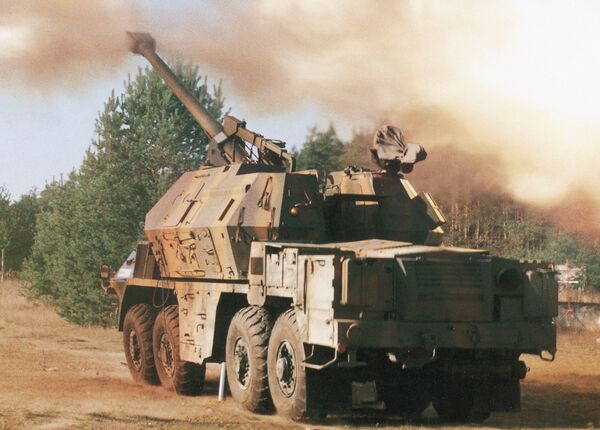- About
- Intara
- Capabilities
- Advisory
- Resources
- News
- Store
Future Artillery 2023: Slovakia transforms artillery
05 June 2023
by Nicholas Fiorenza


Slovak self-propelled artillery battalions are equipped with the Zuzana self-propelled howitzer armed with a 155 mm gun. (Kerametal)
Janes learnt details of the plans for the Slovak Armed Forces' artillery on the last day of Defence iQ's Future Artillery 2023 conference held in Munich from 30 May to 1 June.
The branch will see its 5th Artillery Regiment become a brigade again in 2035, as it was before April 2005, with its battalions to be assigned to manoeuvre brigades.
The regiment consists of the 21st Self-Propelled Artillery Battalion with Zuzana 2 self-propelled howitzers (SPHs), the 51st Self-Propelled Artillery Battalion with Zuzana 2000 SPHs, the 53rd Artillery Battalion with D-30 towed howitzers, the 54th Multiple Rocket Launcher (MRL) Battalionwith RM-70 MRLs, and an anti-tank unit with Spike LR2 anti-tank guided missiles.
Ukraine conflict: Germany pays for US HIMARS for Kyiv, Canada provides air-defence funding
15 May 2024
by Nicholas Fiorenza


Germany will pay for three US HIMARSs for Ukraine. (Janes/Patrick Allen)
German Defence Minister Boris Pistorius announced during a visit to Washington, DC on 8–9 May that Berlin would pay for US High-Mobility Artillery Rocket Systems (HIMARSs) for Ukraine. Germany will pay for three HIMARSs from US stocks.
During Pistorius's visit to Ottawa on 10 May, Canadian Minister of National Defence Bill Blair signed an agreement with his German counterpart to contribute CAD76 million (USD55.6 million) to the Immediate Action on Air Defence (IAAD) initiative. Launched by Germany in April, the initiative pools money and resources from the international community to quickly source and deliver air-defence systems for Ukraine.
The Netherlands is contributing EUR150 million (USD162 million) to the IAAD.
Germany is providing an additional Patriot air-defence system to Ukraine. This is in addition to two already supplied.
Feature: US Army's race for new howitzers, munitions takes off after modernisation effort scuttled
14 May 2024
by Meredith Roaten


In March, the US Army demonstrated its new ERCA capability at Yuma Proving Ground, Arizona. (Janes/Ashley Roque)
US land forces want an artillery system that is more mobile and more lethal. While cutting-edge technology development failed to produce a production-ready system, the US Army is readjusting its acquisition approach and concepts of operations for artillery.
The army has determined that its Extended Range Cannon Artillery (ERCA) Program of Record is not an option for future artillery warfare, Doug Bush, assistant secretary of the army for acquisition, logistics, and technology, announced in March 2024. This decision and more on advanced artillery technology stemmed from a tactical fires study that was completed in 2023 and has not been publicly released, said General James Rainey, commanding general of Army Futures Command (AFC).
ERCA was scheduled to transition to the major capability acquisition pathway after five years of research, development, test, and evaluation (RDT&E), according to the US Government Accountability Office. The army applied for a waiver for an additional year of RDT&E but was denied by the Under Secretary of Defense for Acquisition and Sustainment.
Italy's Grifo test-fired and qualified with CAMM-ER missile
10 May 2024
by Nicholas Fiorenza


The Italian Army's Grifo air-defence system being tested and qualified with CAMM-ER. (MBDA)
The Italian Army's Grifo (Griffon) air-defence system has been test-fired and qualified with the Common Anti-air Modular Missile Extended Range (CAMM-ER) missile, MBDA announced in a press release on 8 May. The company said it was the first time the Grifo's Command Post and Engagement Module (Posto Comando Modulo di Ingaggio: PCMI) integrated with the missile launcher and CAMM-ER missile was tested-fired and qualified.
The test was conducted against a target drone simulating an attack by an enemy aircraft, confirming the defence capabilities and performance of both the missile and the entire system in an integrated mode, according to MBDA.
During the test, the PCMI detected the target drone, which was in attack mode, and then identified and classified the threat, evaluated how to defend against it, and ordered the launch of CAMM-ER to neutralise it. The trial also verified the correct functioning of the two-way datalink between CAMM-ER and the Grifo ground system, MBDA added.
Janes learnt details of the plans for the Slovak Armed Forces' artillery on the last day of Defence ...
Latest Podcasts
The value of OSINT for intelligence sharing
In this episode Harry Kemsley and Sean Corbett are joined by Phil Ritcheson Ph.D. to discuss why intelligence sharing is now more important than ever. They discuss the growing need for allied and partnership and how by using open sources facilit...
Listen nowJanes Case Studies
Using Janes Intara to build a common intelligence picture: Russian build up on the Ukrainian border
View Case StudyNews Categories
 Land Details
Land Details